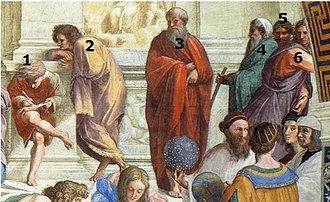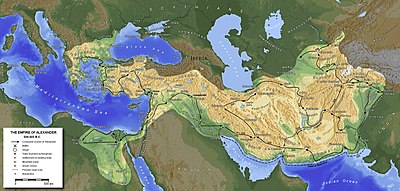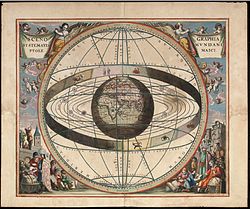From Wikipedia, the free encyclopedia
Eliminativists
argue that modern belief in the existence of mental phenomena is
analogous to the ancient belief in obsolete theories such as the
geocentric model of the universe.
Eliminative materialism (also called eliminativism) is a materialist position in the philosophy of mind. It is the idea that the majority of mental states in folk psychology do not exist. Some supporters of eliminativism argue that no coherent neural basis will be found for many everyday psychological concepts such as belief or desire, since they are poorly defined. The argument is that psychological concepts of behavior and experience should be judged by how well they reduce to the biological level. Other versions entail the nonexistence of conscious mental states such as pain and visual perceptions.
Eliminativism about a class of entities is the view that the class of entities does not exist. For example, materialism tends to be eliminativist about the soul; modern chemists are eliminativist about phlogiston; and modern physicists are eliminativist about luminiferous ether. Eliminative materialism
is the relatively new (1960s–70s) idea that certain classes of mental
entities that common sense takes for granted, such as beliefs, desires,
and the subjective sensation of pain, do not exist. The most common versions are eliminativism about propositional attitudes, as expressed by Paul and Patricia Churchland, and eliminativism about qualia (subjective interpretations about particular instances of subjective experience), as expressed by Daniel Dennett, Georges Rey, and Jacy Reese Anthis. These philosophers often appeal to an introspection illusion.
In the context of materialist understandings of psychology, eliminativism is the opposite of reductive materialism, arguing that mental states as conventionally understood do exist, and directly correspond to the physical state of the nervous system. An intermediate position, revisionary materialism, often argues the mental state in question will prove to be somewhat reducible to physical phenomena—with some changes needed to the commonsense concept.
Since eliminative materialism arguably claims that future
research will fail to find a neuronal basis for various mental
phenomena, it may need to wait for science to progress further. One
might question the position on these grounds, but philosophers like
Churchland argue that eliminativism is often necessary in order to open
the minds of thinkers to new evidence and better explanations. Views closely related to eliminativism include illusionism and quietism.
Overview
Various
arguments have been made for and against eliminative materialism over
the last 50 years. The view's history can be traced to David Hume, who rejected the idea of the "self" on the grounds that it was not based on any impression.
Most arguments for the view are based on the assumption that people's
commonsense view of the mind is actually an implicit theory. It is to be
compared and contrasted with other scientific theories in its
explanatory success, accuracy, and ability to predict the future.
Eliminativists argue that commonsense "folk" psychology has failed and
will eventually need to be replaced by explanations derived from
neuroscience. These philosophers therefore tend to emphasize the
importance of neuroscientific research as well as developments in artificial intelligence.
Philosophers who argue against eliminativism may take several approaches. Simulation theorists, like Robert Gordon and Alvin Goldman,
argue that folk psychology is not a theory, but depends on internal
simulation of others, and therefore is not subject to falsification in
the same way that theories are. Jerry Fodor, among others,
argues that folk psychology is, in fact, a successful (even
indispensable) theory. Another view is that eliminativism assumes the
existence of the beliefs and other entities it seeks to "eliminate" and
is thus self-refuting.
Schematic overview: Eliminativists suggest that some sciences can be
reduced (blue), but that theories that are in principle irreducible will eventually be eliminated (orange).
Eliminativism maintains that the commonsense understanding of the mind is mistaken, and that neuroscience
will one day reveal that mental states talked about in everyday
discourse, using words such as "intend", "believe", "desire", and
"love", do not refer to anything real. Because of the inadequacy of
natural languages, people mistakenly think that they have such beliefs
and desires. Some eliminativists, such as Frank Jackson, claim that consciousness does not exist except as an epiphenomenon of brain function; others, such as Georges Rey, claim that the concept will eventually be eliminated as neuroscience progresses.
Consciousness and folk psychology are separate issues, and it is
possible to take an eliminative stance on one but not the other. The roots of eliminativism go back to the writings of Wilfred Sellars, W.V.O. Quine, Paul Feyerabend, and Richard Rorty. The term "eliminative materialism" was first introduced by James Cornman in 1968 while describing a version of physicalism endorsed by Rorty. The later Ludwig Wittgenstein
was also an important inspiration for eliminativism, particularly with
his attack on "private objects" as "grammatical fictions".
Early eliminativists such as Rorty and Feyerabend often confused
two different notions of the sort of elimination that the term
"eliminative materialism" entailed. On the one hand, they claimed, the cognitive sciences
that will ultimately give people a correct account of the mind's
workings will not employ terms that refer to commonsense mental states
like beliefs and desires; these states will not be part of the ontology of a mature cognitive science. But critics immediately countered that this view was indistinguishable from the identity theory of mind. Quine himself wondered what exactly was so eliminative about eliminative materialism:
Is physicalism a repudiation of
mental objects after all, or a theory of them? Does it repudiate the
mental state of pain or anger in favor of its physical concomitant, or
does it identify the mental state with a state of the physical organism
(and so a state of the physical organism with the mental state)?
On the other hand, the same philosophers claimed that commonsense
mental states simply do not exist. But critics pointed out that
eliminativists could not have it both ways: either mental states exist
and will ultimately be explained in terms of lower-level
neurophysiological processes, or they do not. Modern eliminativists have much more clearly expressed the view that
mental phenomena simply do not exist and will eventually be eliminated
from people's thinking about the brain in the same way that demons have
been eliminated from people's thinking about mental illness and
psychopathology.
While it was a minority view in the 1960s, eliminative materialism gained prominence and acceptance during the 1980s. Proponents of this view, such as B.F. Skinner, often made parallels to previous superseded scientific theories (such as that of the four humours, the phlogiston theory of combustion, and the vital force
theory of life) that have all been successfully eliminated in
attempting to establish their thesis about the nature of the mental. In
these cases, science has not produced more detailed versions or
reductions of these theories, but rejected them altogether as obsolete. Radical behaviorists, such as Skinner, argued that folk psychology is already obsolete and should be replaced by descriptions of histories of reinforcement and punishment. Such views were eventually abandoned. Patricia and Paul Churchland argued that folk psychology will be gradually replaced as neuroscience matures.
Eliminativism is not only motivated by philosophical
considerations, but is also a prediction about what form future
scientific theories will take. Eliminativist philosophers therefore tend
to be concerned with data from the relevant brain and cognitive sciences.
In addition, because eliminativism is essentially predictive in nature,
different theorists can and often do predict which aspects of folk
psychology will be eliminated from folk psychological vocabulary. None
of these philosophers are eliminativists tout court.
Today, the eliminativist view is most closely associated with the Churchlands, who deny the existence of propositional attitudes (a subclass of intentional states), and with Daniel Dennett, who is generally considered an eliminativist about qualia
and phenomenal aspects of consciousness. One way to summarize the
difference between the Churchlands' view and Dennett's is that the
Churchlands are eliminativists about propositional attitudes, but reductionists about qualia, while Dennett is an anti-reductionist about propositional attitudes and an eliminativist about qualia.
More recently, Brian Tomasik and Jacy Reese Anthis have made various arguments for eliminativism.[ Elizabeth Irvine has argued that both science and folk psychology do not treat mental states
as having phenomenal properties so the hard problem "may not be a
genuine problem for non-philosophers (despite its overwhelming
obviousness to philosophers), and questions about consciousness may well
'shatter' into more specific questions about particular capacities." In 2022, Anthis published Consciousness Semanticism: A Precise Eliminativist Theory of Consciousness,
which asserts that "formal argumentation from precise semantics"
dissolves the hard problem because of the contradiction between
precision implied in philosophical theory and the vagueness in its
definition, which implies there is no fact of the matter for
phenomenological consciousness.
Arguments for eliminativism
Problems with folk theories
Eliminativists such as Paul and Patricia Churchland argue that folk psychology
is a fully developed but non-formalized theory of human behavior. It is
used to explain and make predictions about human mental states and
behavior. This view is often referred to as the theory of mind or just simply theory-theory, for it theorizes the existence of an unacknowledged theory. As a theory
in the scientific sense, eliminativists maintain, folk psychology must
be evaluated on the basis of its predictive power and explanatory
success as a research program for the investigation of the mind/brain.
Such eliminativists have developed different arguments to show
that folk psychology is a seriously mistaken theory and should be
abolished. They argue that folk psychology excludes from its purview or
has traditionally been mistaken about many important mental phenomena
that can and are being examined and explained by modern neuroscience.
Some examples are dreaming, consciousness, mental disorders, learning processes, and memory
abilities. Furthermore, they argue, folk psychology's development in
the last 2,500 years has not been significant and it is therefore
stagnant. The ancient Greeks
already had a folk psychology comparable to modern views. But in
contrast to this lack of development, neuroscience is rapidly
progressing and, in their view, can explain many cognitive processes that folk psychology cannot.
Folk psychology retains characteristics of now obsolete theories
or legends from the past. Ancient societies tried to explain the
physical mysteries of nature
by ascribing mental conditions to them in such statements as "the sea
is angry". Gradually, these everyday folk psychological explanations
were replaced by more efficient scientific descriptions. Today,
eliminativists argue, there is no reason not to accept an effective
scientific account of cognition. If such an explanation existed, then
there would be no need for folk-psychological explanations of behavior,
and the latter would be eliminated the same way as the mythological explanations the ancients used.
Another line of argument is the meta-induction based on what
eliminativists view as the disastrous historical record of folk theories
in general. Ancient pre-scientific "theories" of folk biology, folk
physics, and folk cosmology have all proven radically wrong.
Eliminativists argue the same in the case of folk psychology. There
seems no logical basis, to the eliminativist, to make an exception just
because folk psychology has lasted longer and is more intuitive or
instinctively plausible than other folk theories.
Indeed, the eliminativists warn, considerations of intuitive
plausibility may be precisely the result of the deeply entrenched nature
in society of folk psychology itself. It may be that people's beliefs
and other such states are as theory-laden as external perceptions and
hence that intuitions will tend to be biased in their favor.
Specific problems with folk psychology
Much of folk psychology involves the attribution of intentional states (or more specifically as a subclass, propositional attitudes).
Eliminativists point out that these states are generally ascribed
syntactic and semantic properties. An example of this is the language of thought
hypothesis, which attributes a discrete, combinatorial syntax and other
linguistic properties to these mental phenomena. Eliminativists argue
that such discrete, combinatorial characteristics have no place in
neuroscience, which speaks of action potentials, spiking frequencies,
and other continuous and distributed effects. Hence, the syntactic
structures assumed by folk psychology have no place in such a structure
as the brain.
To this there have been two responses. On the one hand, some
philosophers deny that mental states are linguistic and see this as a straw man argument. The other view is represented by those who subscribe to "a language of thought". They assert that mental states can be multiply realized and that functional characterizations are just higher-level characterizations of what happens at the physical level.
It has also been argued against folk psychology that the
intentionality of mental states like belief imply that they have
semantic qualities. Specifically, their meaning is determined by the
things they are about in the external world. This makes it difficult to
explain how they can play the causal roles they are supposed to in
cognitive processes.
In recent years, this latter argument has been fortified by the theory of connectionism.
Many connectionist models of the brain have been developed in which the
processes of language learning and other forms of representation are
highly distributed and parallel. This tends to indicate that such
discrete and semantically endowed entities as beliefs and desires are
unnecessary.
Physics eliminates intentionality
If
a thought is a kind of neural process, then when one thinks about
Paris, some network of neurons is somehow about Paris. Consider various
accounts of this possibility. The neurons cannot be about Paris in the
way a picture is, because unlike a picture, they do not resemble Paris.
But neither can they be about Paris in the way that a red octagonal stop
sign is about stopping even though it does not resemble that action.
For a red octagon, or the word "stop" for that matter, only mean what
they do as a matter of convention, only because we interpret the shapes
in question as representing the action of stopping. And when you think
about Paris, no one is assigning a conventional interpretation to
such-and-such neurons in your brain so as to make them represent Paris.
To suggest that some further brain process assigns such a meaning to the
purported "Paris neurons" is merely to commit a homunculus fallacy and
explains nothing. For if we say that one clump of neurons assigns
meaning to another, we are saying that the one represents the other as
having such-and-such a meaning. That means that we now have to explain
how the first possesses the meaning or representational content by
virtue of which it does that, which entails that we have not solved the
first problem but only added a second one. We have "explained" the
meaning of one clump of neurons by reference to meaning implicitly
present in another clump, and thus merely initiated a vicious
explanatory regress. The only way to break the regress is to postulate
some bit of matter that just has its meaning intrinsically, without
deriving it from anything else. But there can be no such bit of matter,
because physics has ruled out the existence of clumps of matter of that
sort.
Evolution eliminates intentionality
Any naturalistic, purely causal, non-semantic account of content must rely on Darwinian natural selection
to build neural states capable of storing unique propositions, as
required by folk psychology. Theories that attempt to account for intentionality
within materialism face the disjunction problem, which results in the
indeterminacy of propositional content. If such theories cannot solve
the disjunction problem, then neurons cannot store unique propositions.
The only process that can build neural circuits, evolution by natural
selection, cannot solve the disjunction problem. The whole point of
Darwin's theory is that in the creation of adaptations, nature is not
active but passive. What is really going on is environmental
filtration—a purely passive and not very discriminating process that
prevents most traits below some minimal local threshold from persisting.
Natural selection is selection against. Selection for
requires foresight, planning, and purpose. Darwin's achievement was to
show that the appearance of purpose belies the reality of purposeless,
unforesighted, unplanned, mindless causation. All adaptation requires is
selection against. That was Darwin's point. But the combination of
blind variation and selection against is not possible without
disjunctive outcomes.
It is important that selection against is not the contradictory
of selection for, i.e. that selection against trait T is not just
selection for trait not-T. This is because there are traits that are
neither selected against nor selected for: the neutral ones that
biologists, especially molecular evolutionary biologists, call silent,
switched off, junk, non-coding, etc. Selection for and selection against
are contraries, not contradictories.
Natural selection cannot discriminate between coextensive
properties. To see how Darwinian selection against works in a real case,
consider two distinct gene products, one of which is neutral or even
harmful to an organism and the other of which is beneficial, that are
coded for by adjacent genes on the chromosomes. This is the phenomenon
of genetic linkage. The traits that the genes coded for will be
coextensive in a population because the gene-types are coextensive in
that population. Mendelian assortment and segregation do not break up
these packages of genes with any efficiency. Only crossover, the
breaking up and faulty re-annealing of chromosomal strings or similar
processes, can do this. As Darwin realized, no process producing
variants in nature picks up on future usefulness, convenience, need, or
adaptational value. The only thing evolution (natural selection-against)
can do about the free-riding maladaptive or neutral trait, whose genes
are riding along close to the genes for an adaptive trait, is wait
around for the genetic material to be broken at just the right place,
between the genes. Once this happens, Darwinian processes can begin to
tell the difference between them. But only when environmental
vicissitudes break up the DNA on which the two adjacent genes sit can
selection against get started—if one of the two proteins is harmful.
Darwinian theory's disjunction problem is that the process Darwin
discovered cannot tell the difference between these two genes or their
traits until crossover breaks the linkage between one gene, which is
going to increase its frequency, and the other, which is going to
decrease its frequency. If they are never separated, it will remain
blind to their differences forever. What is worse, and more likely, one
gene sequence can code for a favorable trait—a protein required for
survival—while part of the same sequence can code for a maladaptive
trait—some gene product that reduces fitness. Natural selection will
have an even harder time discriminating between these two traits. Since
evolution cannot solve the disjunction problem, the right conclusion for
the materialist is to accept eliminativism by denying that neural
states have as their informational content specific, particular,
determinate statements that attribute non-disjunctive properties and
relations to non-disjunctive subjects.
Arguments against eliminativism
Intentionality and consciousness are identical
Some
eliminativists reject intentionality while accepting the existence of
qualia. Other eliminativists reject qualia while accepting
intentionality. Many philosophers argue that intentionality cannot exist
without consciousness and vice versa, and so any philosopher who
accepts one while rejecting the other is being inconsistent. They argue
that, to be consistent, one must accept both qualia and intentionality
or reject them both. Philosophers who argue for such a position include Philip Goff, Terence Horgan, Uriah Kriegal, and John Tienson. The philosopher Keith Frankish
accepts the existence of intentionality but holds to illusionism about
consciousness because he rejects qualia. Goff notes that beliefs are a
kind of propositional thought.
Intuitive reservations
The
thesis of eliminativism seems so obviously wrong to many critics, who
find it undeniable that people know immediately and indubitably that
they have minds, that argumentation seems unnecessary. This sort of
intuition-pumping is illustrated by asking what happens when one asks
oneself honestly if one has mental states.
Eliminativists object to such a rebuttal of their position by claiming
that intuitions often are mistaken. Analogies from the history of
science are frequently invoked to buttress this observation: it may
appear obvious that the sun travels around the earth, for example, but
this was nevertheless proved wrong. Similarly, it may appear obvious
that apart from neural events there are also mental conditions, but that
could be false.
But even if one accepts the susceptibility to error of people's
intuitions, the objection can be reformulated: if the existence of
mental conditions seems perfectly obvious and is central to our
conception of the world, then enormously strong arguments are needed to
deny their existence. Furthermore, these arguments, to be consistent,
must be formulated in a way that does not presuppose the existence of
entities like "mental states", "logical arguments", and "ideas", lest
they be self-contradictory.
Those who accept this objection say that the arguments for
eliminativism are far too weak to establish such a radical claim and
that there is thus no reason to accept eliminativism.
Self-refutation
Some philosophers, such as Paul Boghossian, have attempted to show that eliminativism is in some sense self-refuting, since the theory presupposes the existence of mental phenomena. If eliminativism is true, then eliminativists must accept an intentional property like truth,
supposing that in order to assert something one must believe it. Hence,
for eliminativism to be asserted as a thesis, the eliminativist must
believe that it is true; if so, there are beliefs, and eliminativism is
false.
Georges Rey and Michael Devitt reply to this objection by invoking deflationary semantic theories that avoid analyzing predicates
like "x is true" as expressing a real property. They are instead
construed as logical devices, so that asserting that a sentence is true
is just a quoted way of asserting the sentence itself. To say "'God
exists' is true" is just to say "God exists". This way, Rey and Devitt
argue, insofar as dispositional replacements of "claims" and
deflationary accounts of "true" are coherent, eliminativism is not
self-refuting.
Correspondence theory of truth
Several philosophers, such as the Churchlands and Alex Rosenberg,
have developed a theory of structural resemblance or physical
isomorphism that could explain how neural states can instantiate truth
within the correspondence theory of truth.
Neuroscientists use the word "representation" to identify the neural
circuits' encoding of inputs from the peripheral nervous system in, for
example, the visual cortex. But they use the word without according it
any commitment to intentional content. In fact, there is an explicit
commitment to describing neural representations in terms of structures
of neural axonal discharges that are physically isomorphic to the inputs
that cause them. Suppose that this way of understanding representation
in the brain is preserved in the long-term course of research providing
an understanding of how the brain processes and stores information. Then
there will be considerable evidence that the brain is a neural network
whose physical structure is identical to the aspects of its environment
it tracks and whose representations of these features consist in this
physical isomorphism.
Experiments in the 1980s with macaques
isolated the structural resemblance between input vibrations the finger
feels, measured in cycles per second, and representations of them in
neural circuits, measured in action-potential spikes per second. This
resemblance between two easily measured variables makes it unsurprising
that they would be among the first such structural resemblances to be
discovered. Macaques and humans have the same peripheral nervous system
sensitivities and can make the same tactile discriminations. Subsequent
research into neural processing has increasingly vindicated a structural
resemblance or physical isomorphism approach to how information enters
the brain and is stored and deployed.
This isomorphism between brain and world is not a matter of some
relationship between reality and a map of reality stored in the brain.
Maps require interpretation if they are to be about what they map, and
eliminativism and neuroscience share a commitment to explaining the
appearance of aboutness by purely physical relationships between
informational states in the brain and what they "represent". The
brain-to-world relationship must be a matter of physical
isomorphism—sameness of form, outline, structure—that does not require
interpretation.
This machinery can be applied to make "sense" of eliminativism in
terms of the sentences eliminativists say or write. When we say that
eliminativism is true, that the brain does not store information in the
form of unique sentences, statements, expressing propositions or
anything like them, there is a set of neural circuits that has no
trouble coherently carrying this information. There is a possible
translation manual that will guide us back from the vocalization or
inscription eliminativists express to these circuits. These neural
structures will differ from the neural circuits of those who explicitly
reject eliminativism in ways that our translation manual will presumably
shed some light on, giving us a neurological handle on disagreement and
on the structural differences in neural circuitry, if any, between
asserting p and asserting not-p when p expresses the eliminativist
thesis.
Criticism
The
physical isomorphism approach faces indeterminacy problems. Any given
structure in the brain will be causally related to, and isomorphic in
various respects to, many different structures in external reality. But
we cannot discriminate the one it is intended to represent or that it is
supposed to be true "of". These locutions are heavy with just the
intentionality that eliminativism denies. Here is a problem of
underdetermination or holism that eliminativism shares with
intentionality-dependent theories of mind. Here, we can only invoke
pragmatic criteria for discriminating successful structural
representations—the substitution of true ones for unsuccessful ones—the
ones we used to call false.
Dennett notes that it is possible that such indeterminacy
problems remain only hypothetical, not occurring in reality. He
constructs a 4x4 "Quinian crossword puzzle" with words that must satisfy
both the across and down definitions. Since there are multiple
constraints on this puzzle, there is one solution. Thus we can think of
the brain and its relation to the external world as a very large
crossword puzzle that must satisfy exceedingly many constraints to which
there is only one possible solution. Therefore, in reality we may end
up with only one physical isomorphism between the brain and the external
world.
Pragmatic theory of truth
When
indeterminacy problems arose because the brain is physically isomorphic
to multiple structures of the external world, it was urged that a
pragmatic approach be used to resolve the problem. Another approach
argues that we the pragmatic theory of truth should be used from the start to decide whether certain neural circuits store true information about the external world. Pragmatism was founded by Charles Sanders Peirce and William James, and later refined by our understanding of the philosophy of science. According to pragmatism, to say that general relativity is true is to say that it makes more accurate predictions than other theories (Newtonian mechanics, Aristotle's physics,
etc.). If computer circuits lack intentionality and do not store
information using propositions, then in what sense can computer A have
true information about the world while computer B lacks it? If the
computers were instantiated in autonomous cars,
we could test whether A or B successfully complete a cross-country road
trip. If A succeeds while B fails, the pragmatist can say that A holds
true information about the world, because A's information allows it to
make more accurate predictions (relative to B) about the world and to
move around its environment more successfully. Similarly, if brain A has
information that enables the biological organism to make more accurate
predictions about the world and helps the organism successfully move
around in the environment, then A has true information about the world.
Although not advocates of eliminativism, John Shook and Tibor Solymosi
argue that pragmatism is a promising program for understanding
advancements in neuroscience and integrating them into a philosophical
picture of the world.
Criticism
The
reason naturalism cannot be pragmatic in its epistemology starts with
its metaphysics. Science tells us that we are components of the natural
realm, indeed latecomers in the 13.8-billion-year-old universe. The
universe was not organized around our needs and abilities, and what
works for us is just a set of contingent facts that could have been
otherwise. Among the sciences' explananda of the set of things that work
for us. Once we have begun discovering things about the universe that
work for us, science sets out to explain why they do. It is clear that
one explanation for why things work for us that we must rule out as
unilluminating, indeed question-begging, is that they work for us
because they work for us. If something works for us, enables us to meet
our needs and wants, there must be an explanation reflecting facts about
us and the world that produce the needs and the means to satisfy them.
The explanation of why scientific methods work for us must be a
causal explanation. It must show what facts about reality make the
methods we employ to acquire knowledge suitable for doing so. The
explanation must show that our methods work —for example, have reliable
technological application— not by coincidence, still less miracle or
accident. That means there must be some facts, events, processes that
operate in reality and brought about our pragmatic success. The demand
that success be explained is a consequence of science's epistemology. If
the truth of such explanations consists in the fact that they work for
us (as pragmatism requires), then the explanation of why our scientific
methods work is that they work. That is not a satisfying explanation.
Qualia
Another problem for the eliminativist is the consideration that human beings undergo subjective experiences and hence their conscious mental states have qualia.
Since qualia are generally regarded as characteristics of mental
states, their existence does not seem compatible with eliminativism. Eliminativists such as Dennett and Rey respond by rejecting qualia.
Opponents of eliminativism see this response as problematic, since many
claim that existence of qualia is perfectly obvious. Many philosophers
consider the "elimination" of qualia implausible, if not
incomprehensible. They assert that, for instance, the existence of pain
is simply beyond denial.
Admitting that the existence of qualia seems obvious, Dennett
nevertheless holds that "qualia" is a theoretical term from an outdated
metaphysics stemming from Cartesian
intuitions. He argues that a precise analysis shows that the term is in
the long run empty and full of contradictions. Eliminativism's claim
about qualia is that there is no unbiased evidence for such experiences
when regarded as something more than propositional attitudes.
In other words, it does not deny that pain exists, but holds that it
exists independently of its effect on behavior. Influenced by
Wittgenstein's Philosophical Investigations, Dennett and Rey have defended eliminativism about qualia even when other aspects of the mental are accepted.
Quining qualia
Dennett offers philosophical thought experiments to argue that qualia do not exist. First he lists five properties of qualia:
- They are "directly" or "immediately" graspable during our conscious experiences.
- We are infallible about them.
- They are "private": no one can directly access anyone else's qualia.
- They are ineffable.
- They are "intrinsic" and "simple" or "unanalyzable."
Inverted qualia
The first thought experiment Dennett uses to demonstrate that qualia lack the listed necessary properties to exist involves inverted qualia:
consider two people who have different qualia but the same external
physical behavior. But now the qualia supporter can present an
"intrapersonal" variation. Suppose a neurosurgeon works on your brain
and you discover that grass now looks red. Would this not be a case
where we could confirm the reality of qualia—by noticing how the qualia
have changed while every other aspect of our conscious experience
remains the same? Not quite, Dennett replies via the next intuition
pump, "alternative neurosurgery". There are two different ways the
neurosurgeon might have accomplished the inversion. First, they might
have tinkered with something "early on", so that signals from the eye
when you look at grass contain the information "red" rather than
"green". This would result in genuine qualia inversion. But they might
instead have tinkered with your memory. Here your qualia would remain
the same, but your memory would be altered so that your current green
experience would contradict your earlier memories of grass. You would
still feel that the color of grass had changed, but here the qualia have
not changed, but your memories have. Would you be able to tell which of
these scenarios is correct? No: your perceptual experience tells you
that something has changed but not whether your qualia have changed.
Dennett concludes, since (by hypothesis) the two surgical procedures can
yield exactly the same introspective effects while only one inverts the
qualia, nothing in the subject's experience can favor one hypothesis
over the other. So unless he seeks outside help, the state of his own
qualia must be as unknowable to him as the state of anyone else's. It is
questionable, in short, that we have direct, infallible access to our
conscious experience.
The experienced beer drinker
Dennett's
second thought experiment involves beer. Many people think of beer as
an acquired taste: one's first sip is often unpleasant, but one
gradually comes to enjoy it. But wait, Dennett asks—what is the "it"
here? Compare the flavor of that first taste with the flavor now. Does
the beer taste exactly the same both then and now, only now you like
that taste whereas before you disliked it? Or is it that the way beer
tastes gradually shifts—so that the taste you did not like at the
beginning is not the same taste you now like? In fact most people simply
cannot tell which is the correct analysis. But that is to give up again
on the idea that we have special and infallible access to our qualia.
Further, when forced to choose, many people feel that the second
analysis is more plausible. But then if one's reactions to an experience
are in any way constitutive of it, the experience is not so "intrinsic"
after all—and another qualia property falls.
Inverted goggles
Dennett's
third thought experiment involves inverted goggles. Scientists have
devised special eyeglasses that invert up and down for the wearer. When
you put them on, everything looks upside down. When subjects first put
them on, they can barely walk around without stumbling. But after
subjects wear them for a while, something surprising occurs. They adapt
and become able to walk around as easily as before. When you ask them
whether they adapted by re-inverting their visual field or simply got
used to walking around in an upside-down world, they cannot say. So as
in our beer-drinking case, either we simply do not have the special,
infallible access to our qualia that would allow us to distinguish the
two cases or the way the world looks to us is actually a function of how
we respond to the world—in which case qualia are not "intrinsic"
properties of experience.
Criticism
Edward
Feser objects to Dennett's position as follows. That you need to appeal
to third-person neurological evidence to determine whether your memory
of your qualia has been tampered with does not seem to show that your
qualia themselves—past or present—can be known only by appealing to that
evidence. You might still be directly aware of your qualia from the
first-person, subjective point of view even if you do not know whether
they are the same as the qualia you had yesterday—just as you might
really be aware of the article in front of you even if you do not know
whether it is the same as the article you saw yesterday. Questions about
memory do not necessarily bear on the nature of your awareness of
objects present here and now (even if they bear on what you can
justifiably claim to know about such objects), whatever those objects
happen to be. Dennett's assertion that scientific objectivity requires
appealing exclusively to third-person evidence appears mistaken. What
scientific objectivity requires is not denial of the first-person
subjective point of view but rather a means of communicating
inter-subjectively about what one can grasp only from that point of
view. Given the relational structure first-person phenomena like qualia
appear to exhibit—a structure that Carnap
devoted great effort to elucidating—such a means seems available: we
can communicate what we know about qualia in terms of their structural
relations to one another. Dennett fails to see that qualia can be
essentially subjective and still relational or non-intrinsic, and thus
communicable. This communicability ensures that claims about qualia are
epistemologically objective; that is, they can in principle be grasped
and evaluated by all competent observers even though they are claims
about phenomena that are arguably not metaphysically objective, i.e.,
about entities that exist only as grasped by a subject of experience. It
is only the former sort of objectivity that science requires. It does
not require the latter, and cannot plausibly require it if the
first-person realm of qualia is what we know better than anything else.
Illusionism
Illusionism is an active program within eliminative materialism to explain phenomenal consciousness as an illusion. It is promoted by the philosophers Daniel Dennett, Keith Frankish, and Jay Garfield, and the neuroscientist Michael Graziano. Graziano has advanced the attention schema theory of consciousness and postulates that consciousness is an illusion. According to David Chalmers,
proponents argue that once we can explain consciousness as an illusion
without the need for a realist view of consciousness, we can construct a
debunking argument against realist views of consciousness. This line of argument draws from other debunking arguments like the evolutionary debunking argument in the field of metaethics. Such arguments note that morality is explained by evolution without positing moral realism, so there is a sufficient basis to debunk moral realism.
Criticism
Illusionists
generally hold that once it is explained why people believe and say
they are conscious, the hard problem of consciousness will dissolve.
Chalmers agrees that a mechanism for these beliefs and reports can and
should be identified using the standard methods of physical science, but
disagrees that this would support illusionism, saying that the datum
illusionism fails to account for is not reports of consciousness but
rather first-person consciousness itself.
He separates consciousness from beliefs and reports about
consciousness, but holds that a fully satisfactory theory of
consciousness should explain how the two are "inextricably intertwined"
so that their alignment does not require an inexplicable coincidence. Illusionism has also been criticized by the philosopher Jesse Prinz.
Efficacy of folk psychology
Some philosophers argue that folk psychology is quite successful.
Simulation theorists doubt that people's understanding of the mental
can be explained in terms of a theory at all. Rather they argue that
people's understanding of others is based on internal simulations of how
they would act and respond in similar situations. Jerry Fodor
believes in folk psychology's success as a theory, because it makes for
an effective way of communication in everyday life that can be
implemented with few words. Such effectiveness could not be achieved
with complex neuroscientific terminology.











